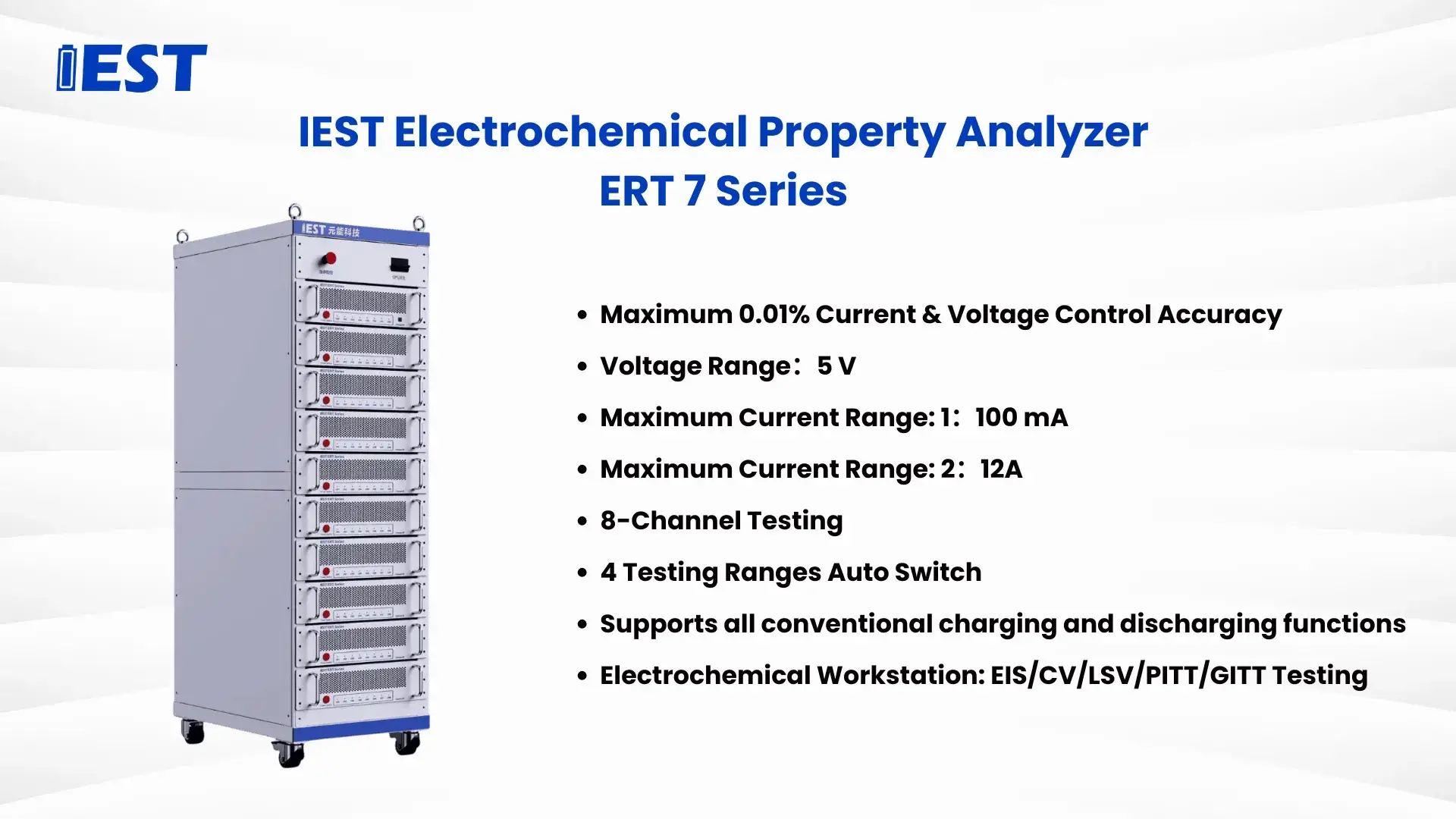-
iestinstrument
Detailed Explanation of 24 Charge-Discharge Steps
1. Background
In battery R&D and quality control, charge-discharge test equipment serves as a “diagnostic center” for cells. By precisely controlling parameters such as current, voltage, and temperature, it not only measures fundamental metrics like capacity and efficiency but also deeply analyzes material properties, aging mechanisms, and safety risks. However, faced with complex testing requirements, how does one select appropriate step combinations? How can key data be captured through parameter configuration?
This article systematically outlines 24 core charge-discharge steps, spanning from basic constant-current operations to advanced pulse/EIS testing, enabling you to:
-
Rapidly match test scenarios (formation, lifecycle, fast-charge, low-temperature performance)
-
Precisely interpret parameter logic (primary parameters, transition conditions, data recording)
-
Avoid common testing pitfalls (overcharge protection, temperature compensation, polarization mitigation)
All steps are developed by IEST Instrument R&D team. Modular step editing requires no programming expertise for rapid deployment. Contact us for details on IEST high-precision battery cycler test systems!
2. Step Catalog
2.1 Rest
Purpose: Suspends charge/discharge to stabilize cell state or await external triggers.
Transition Conditions: Time termination (default). Optional: Voltage threshold (e.g., post-rest fluctuation ≤0.01V), temperature threshold (requires auxiliary module).
Data Recorded: Voltage, temperature, auxiliary parameters (e.g., pressure) at fixed intervals.
Applications: Inter-cycle polarization recovery; pre-test stabilization.
2.2 Constant-Current (CC) Charge
Purpose: Charges at fixed current until voltage/time/temperature limits.
Primary Parameter: Charge current (absolute or C-rate).
Transition Conditions: Voltage limit (e.g., 4.2V), time limit, temperature limit (e.g., ≥45°C).
Applications: Fast charging, formation, polarization studies, capacity calibration.
2.3 Constant-Current (CC) Discharge
Purpose: Discharges at fixed current until voltage/capacity/time limits.
Primary Parameter: Discharge current (e.g., 0.5C).
Transition Conditions: Voltage limit (e.g., 2.8V), capacity limit (e.g., 80% nominal capacity), time limit.
Applications: Discharge performance evaluation at varied C-rates.
2.4 Constant-Voltage (CV) Charge
Purpose: Charges at fixed voltage; current decays to cutoff.
Primary Parameter: Charge voltage (e.g., 4.2V).
Transition Conditions: Current cutoff (e.g., 0.05C), time limit.
Applications: Saturation charging; overcharge prevention.
Note: Initial CC phase transitions to CV upon reaching target voltage.
2.5 Constant-Voltage (CV) Discharge
Purpose: Discharges at fixed voltage; current adjusts with load.
Primary Parameter: Discharge voltage (e.g., 3.0V).
Transition Conditions: Current limit (e.g., ≤0.05C), time limit.
Applications: Simulating regulated power output; load-response testing.
2.6 CC-CV Charge
Purpose: CC charge → CV charge until current cutoff.
Primary Parameters: CC current (e.g., 1C), CV voltage (e.g., 4.2V).
Transition Conditions: CV time limit, CV current cutoff (e.g., 0.05C).
Applications: Standard Li-ion charging (e.g., consumer electronics).
2.7 CC-CV Discharge
Purpose: CC discharge → CV discharge until current cutoff.
Primary Parameters: CC current (e.g., 0.5C), CV voltage (e.g., 2.8V).
Transition Conditions: CV time limit, CV current cutoff.
Applications: Precise available capacity measurement.
2.8 Cycle
Purpose: Executes user-defined charge-discharge sequences repeatedly.
Primary Parameter: Cycle count (e.g., 100).
Sub-step Configuration: e.g., [CC-CV Charge → Rest → CC Discharge].
Transition Conditions: Capacity fade (e.g., ≤80%), temperature limit (e.g., ≥50°C).
Applications: Lifecycle testing; aging modeling.
2.9 Conditional Jump
Purpose: Branches to specified steps based on real-time conditions (IF-THEN logic).
Primary Parameter: Trigger thresholds (voltage/current/temperature/capacity).
Target Step: Designated step number.
Applications: Adaptive testing protocols; emergency response.
2.10 Pause
Purpose: Halts test until user manually resumes.
Trigger Conditions: e.g., after every 5 cycles.
Applications: Mid-test inspections; segmented long-term testing.
2.11 Constant-Power (CP) Charge
Purpose: Charges at fixed power; voltage/current dynamically adjust.
Primary Parameter: Charge power (e.g., 10W).
Transition Conditions: Voltage limit, time limit.
Applications: Fast-charge protocol validation (e.g., PD/QC); thermal profiling.
2.12 Constant-Power (CP) Discharge
Purpose: Discharges at fixed power; voltage/current dynamically adjust.
Primary Parameter: Discharge power (e.g., 20W).
Transition Conditions: Voltage limit, time limit.
Applications: Dynamic load simulation (e.g., power tools); peak power capability testing.
2.13 Constant-Resistance (CR) Charge
Purpose: Charges through fixed resistor; current decays with voltage rise.
Primary Parameter: Resistance value (e.g., 10Ω).
Applications: Educational demonstrations; low-efficiency charging scenarios.
2.14 Constant-Resistance (CR) Discharge
Purpose: Discharges through fixed resistor; current decays with voltage drop.
Primary Parameter: Resistance value (e.g., 5Ω).
Applications: Basic discharge characterization (e.g., lead-acid); cost-effective discharge.
2.15 Thermal Chamber Synchronization
Purpose: Controls external chamber for precise environmental conditioning.
Primary Parameters: Target temperature (e.g., -40°C–85°C), ramp rate (e.g., 5°C/min).
Applications: Temperature-dependent performance validation; BMS thermal logic testing.
Note: Currently compatible only with IEST chambers; custom protocol development available.
2.16 EIS (Electrochemical Impedance Spectroscopy)
Purpose: Applies AC perturbation (0.01Hz–100kHz) to measure impedance response.
Primary Parameters: Frequency range, mode (potentiostatic/galvanostatic/dynamic), amplitude (e.g., 10mV or 50mA).
Output Data: Nyquist plots, Bode plots.
Applications: SEI/CEI analysis; charge-transfer resistance quantification.
*Precautions: Avoid electromagnetic interference; use 4-wire measurement for high frequency.*
2.17 CV (Cyclic Voltammetry)
Purpose: Linear voltage sweep to study redox reversibility/kinetics.
Primary Parameters: Scan rate (e.g., 10mV/s), voltage range (e.g., 2.5V–4.2V).
Output Data: I-V curves, oxidation/reduction peaks.
Applications: Electrode reversibility assessment; catalyst surface area calculation.
2.18 LSV (Linear Sweep Voltammetry)
Purpose: Single-direction voltage sweep to analyze reaction onset/diffusion limits.
Primary Parameters: Scan rate, start/end voltage.
Applications: Kinetic parameter extraction (e.g., exchange current density); corrosion studies.
2.19 CA (Chronoamperometry)
Purpose: Measures current decay at fixed voltage.
Primary Parameters: Voltage hold, duration.
Applications: Capacitive behavior analysis; voltage-polarization stability.
2.20 CP (Chronopotentiometry)
Purpose: Tracks voltage evolution at fixed current.
Primary Parameters: Current hold, duration.
Applications: Lithium plating/stripping overpotential studies; phase-transition analysis.
2.21 GITT (Galvanostatic Intermittent Titration Technique)
Purpose: Alternates current pulses with relaxation to compute Li⁺ diffusion coefficients.
Primary Parameters: Pulse current/duration, relaxation time.
Output Data: Voltage relaxation profiles, diffusion coefficient (D).
Applications: Cathode diffusion kinetics; full-cell transport bottleneck analysis.
2.22 PITT (Potentiostatic Intermittent Titration Technique)
Purpose: Alternates voltage steps with relaxation to measure thermodynamic/transport properties.
Primary Parameters: Voltage step size, relaxation current cutoff.
Applications: Phase-transition thermodynamics; solid electrolyte interface characterization.
2.23 Leakage Current Test
Purpose: Quantifies self-discharge under voltage hold.
Primary Parameters: Rest duration (for stabilization), hold voltage.
Applications: Charge retention assessment.
Precautions: Requires strict temperature/humidity control.
2.24 Pulse Step
Purpose: Applies intermittent current pulses to simulate dynamic loads.
Primary Parameters: Pulse amplitude (charge/discharge), duration, cycle count.
Applications: HPPC-based resistance estimation; dynamic response validation; real-world usage simulation (EVs, wearables).
Precautions: Pulse amplitude must not exceed cell specification.
Contact Us
If you are interested in our products and want to know more details, please leave a message here, we will reply you as soon as we can.



